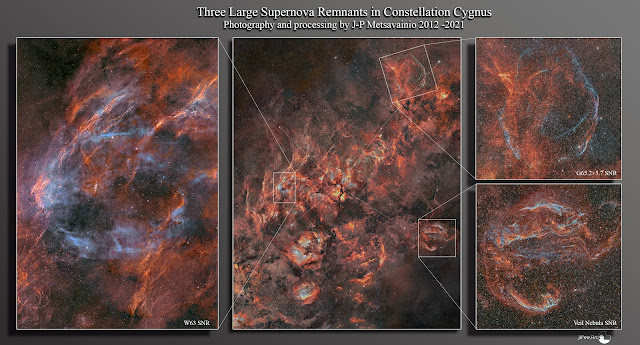COPYRIGHT, PLEASE NOTE
Wednesday, February 23, 2022
Super Zoom to my photo, the Grand Mosaic of the Milky Way Revision 2
- Panorama spans 145 x 22 degrees of sky (Full Moon covers 0,5 degrees of sky)
- Resolution 120.000 x 18.000 pixels
- Photos has 2.2 gigapixels in it, the spatial resolution is equal to 8.8 gigapixel image from color camera since all the channels are in native resolution.
- There are least nine confirmed supernova remnants in this panorama
- About 25 million stars are visible in the photo
- Distance to the nebulae in the image between 350 to 20.000 light years
- Exposure time over 1500 hours between 2009 - 2021
- 301 individual images are stitched together seamlessly
- It took about 12 years to finalize this photo
- Narrowband image from light of ionized elements, hydrogen = green, sulfur = red and oxygen = blue
- Processing time for the whole panorama, way too large part of my life
Monday, February 14, 2022
Supernova remnant HB3 and the cosmic heart
I have shot this target originally at January 14 2020 and it was the second light to my modified Tokina lens. Now I have reprocessed the data and I do like this result much better.
new imaging system based on Tokina AT-x 300mm f2.8 camera lens.
SNR 132.7+1.3 at upper right. Source and more information, http://galaxymap.org/drupal/node/103
5nm H-alpha 3nm S-II and 3nm O-III
O-III, 3x 600 s, binned 1x1 = 30 min..
S-II, 2x1200 s, binned 2x2 = 40 min.
Wednesday, January 5, 2022
Cygnus Mosaic in Visual Colors
Three Musketeers of Swan
There are three large supernova remnants visible in this image. The Veil nebula is the most bright of them, other two are really dim and diffused. I spent about 200 exposure hours for those two alone to show them well. I call this trio to the Three musketeers.
I like the new composition, it's very dynamic and shows the whole constellation Cygnus first time ever at this detail level and deepness. I haven't seen anything like this before. Image spans now 31 x 23 degrees of sky and has 118 individual frames in it. total exposure time is now around 700 hours and the resolution 20.000 x 25.500 pixels. Image it took over a decade to finalize this photo between 2010 and 2021.
The mapped color version of this mosaic can be seen here, https://astroanarchy.blogspot.com/2021/12/cygnus-mosaic-gets-large.html
Click for a large image
Click for a large image
Beside three supernova remnants there are two Wolf Rayet stars with outer shell formations. NGC 6888, the Crescent Nebula at center of the image and the WR 134, it can be seen as a blue arch just right from the Crescent Nebula, near the Tulip nebula.
Next to the Tulip Nebula lays a Black hole Cygnus X-1
Constellation Cygnus is an endless source of celestial wonders, both scientifically and aesthetically. For me, as an visual artist, this are of night sky is very inspiring There are endless amount of amazing shapes and structures, I can spend rest of my life just shooting images from this treasury.














